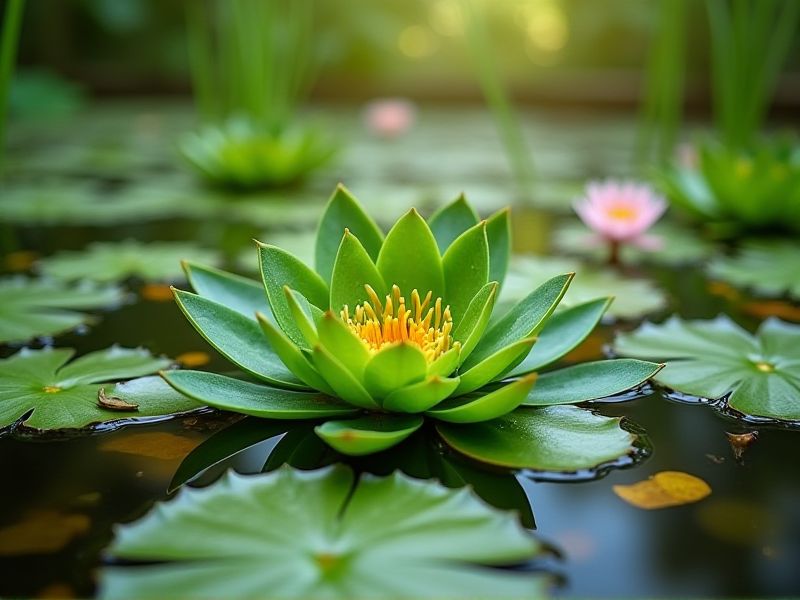
Aquatic plants such as Water Hyacinth, Elodea, and Duckweed play a crucial role in purifying ponds by absorbing excess nutrients, particularly nitrogen and phosphorus, which can lead to algal blooms. These plants enhance water quality through phytoremediation, a process that allows them to filter pollutants and improve oxygen levels in the water. Water lilies and Hornwort not only provide aesthetic beauty but also offer habitat for aquatic life, promoting biodiversity within the ecosystem. By establishing a healthy balance, these plants contribute to creating a thriving aquatic environment, ultimately benefiting fish and other wildlife. To optimize your pond's health, consider incorporating a variety of these species to achieve effective natural filtration and enhance ecological stability.
List of some Aquatic plants that purify ponds
- Water Hyacinth (Eichhornia crassipes)
- Duckweed (Lemna minor)
- Hornwort (Ceratophyllum demersum)
- Water Lettuce (Pistia stratiotes)
- Floating Heart (Nymphoides peltata)
- Pickerel Weed (Pontederia cordata)
- Cattail (Typha latifolia)
- Yellow Flag Iris (Iris pseudacorus)
- Water Mint (Mentha aquatica)
- Anacharis (Elodea canadensis)
Important things about Aquatic plants that purify ponds
Nutrient Absorption
Aquatic plants, such as water hyacinth and duckweed, play a crucial role in nutrient absorption, effectively purifying pond ecosystems. These plants absorb excess nitrogen and phosphorus, reducing nutrient overload that can lead to harmful algal blooms and decreased water quality. By fostering a balanced aquatic environment, they enhance biodiversity and provide habitat for various aquatic organisms. You can improve the health of your ponds significantly by incorporating these natural filtration systems, promoting a cleaner and more sustainable waterway.
Oxygen Production
Aquatic plants, such as water lilies and duckweed, play a crucial role in oxygen production within pond ecosystems. These plants utilize photosynthesis to convert carbon dioxide and sunlight into oxygen, significantly improving water quality for fish and other aquatic life. As they grow, they also absorb excess nutrients, reducing algae blooms and promoting a balanced ecosystem. Creating a habitat with diverse aquatic vegetation not only enhances oxygen levels but also supports biodiversity in your pond.
Algae Control
Aquatic plants such as water lilies, cattails, and duckweed play a crucial role in algae control by enhancing water quality in ponds. These plants absorb excess nutrients like nitrogen and phosphorus, which are often responsible for algae blooms. By stabilizing sediment and providing shade, they create an environment that discourages algae growth while promoting a balanced ecosystem. Incorporating these species into your pond can lead to clearer, healthier water and support diversity in aquatic life.
Habitat Creation
Aquatic plants, such as water lilies and cattails, play a crucial role in purifying ponds by absorbing pollutants and excess nutrients. These plants create habitats for diverse wildlife, including fish and amphibians, which contribute to maintaining the ecosystem's balance. By providing oxygenation through photosynthesis and stabilizing sediments, aquatic vegetation enhances water quality, making the pond healthier for both flora and fauna. Incorporating these plants into your pond design not only supports biodiversity but also minimizes the need for chemical treatments, promoting a more natural and sustainable environment.
Erosion Prevention
Aquatic plants play a crucial role in erosion prevention by stabilizing pond banks with their extensive root systems. Species such as water lilies and cattails not only anchor the soil but also absorb excess nutrients, which helps to reduce algae blooms and improve water clarity. By providing habitat for fish and wildlife, these plants enhance biodiversity and contribute to a healthy ecosystem. Utilizing native aquatic plants in your pond can significantly improve water quality while minimizing erosion and maintaining the integrity of the surrounding environment.
Biodiversity Enhancement
Aquatic plants, such as water lilies, cattails, and duckweed, play a vital role in enhancing biodiversity and improving water quality in ponds. These plants naturally filter pollutants and excess nutrients, creating a healthier ecosystem for fish and other aquatic organisms. By providing habitat and food, they support various species, including insects, amphibians, and birds, which contribute to a balanced aquatic environment. Incorporating a diverse range of native aquatic plants in your pond can significantly increase its ecological health and resilience.
Ph Stabilization
Aquatic plants play a crucial role in pH stabilization within pond ecosystems, enhancing water quality and promoting biodiversity. Species such as water lilies, cattails, and duckweed effectively absorb excess nutrients, reducing algae growth and preventing fluctuations in pH levels. By creating a balanced environment, these plants contribute to improved oxygen availability and habitat for fish and other aquatic organisms. Incorporating diverse aquatic vegetation in your pond can lead to a healthier and more resilient ecosystem.
Water Clarity Improvement
Aquatic plants, such as water lilies, eelgrass, and duckweed, play a vital role in purifying pond water and enhancing clarity. These plants absorb excess nutrients like nitrogen and phosphorus, which reduce algal blooms and consequently improve water visibility. Furthermore, their root systems provide habitats for beneficial microorganisms that break down organic matter, contributing to a healthier aquatic ecosystem. By incorporating native aquatic plants into your pond, you can actively promote a balanced environment and enjoy crystal-clear water year-round.
Toxin Removal
Aquatic plants play a crucial role in purifying ponds by absorbing toxins and excess nutrients from the water. Species such as Water Hyacinth, Cattails, and Duckweed are particularly effective, as their root systems filter and absorb harmful substances like phosphates and nitrates. These plants not only improve water clarity but also provide habitat for beneficial microorganisms that further enhance the detoxification process. Incorporating these aquatic plants into your pond ecosystem will promote a healthier aquatic environment, supporting the overall biodiversity.
Aesthetic Appeal
Aquatic plants such as water lilies, cattails, and hornwort not only enhance the aesthetic charm of your pond but also play a crucial role in maintaining water quality. These plants absorb nutrients and regulate algae growth, creating a balanced ecosystem that keeps your pond crystal clear. Their vibrant colors and textures attract wildlife, making your garden a serene getaway for both you and local fauna. Integrating these species into your pond design ensures a sustainable environment while elevating its visual beauty.
